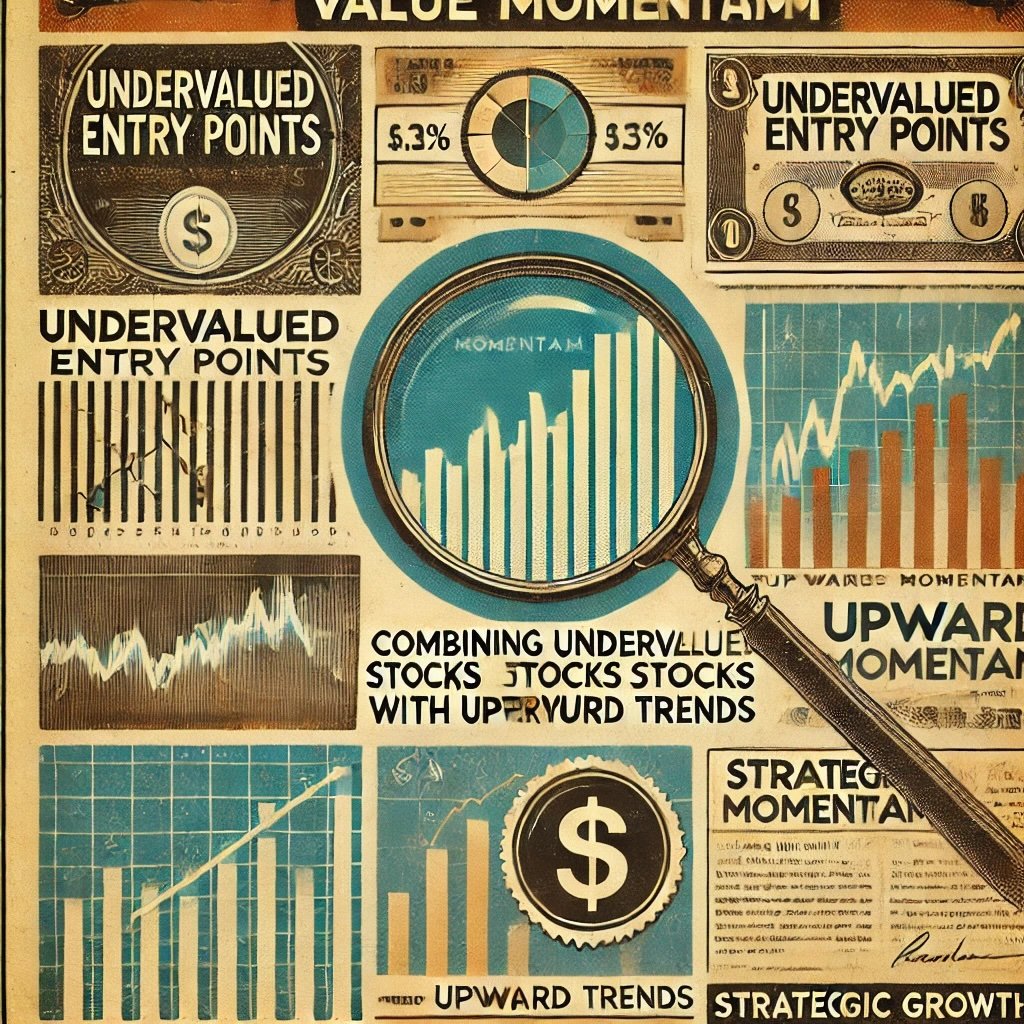Investing like Bruce Kovner means mastering the art of global macro trading, leveraging strategic risk management, and cultivating mental resilience. As the founder of Caxton Associates, one of the world’s most successful hedge funds, Kovner has left an indelible mark on the trading landscape. Whether you’re a novice investor or a seasoned trader, adopting Kovner’s principles can significantly enhance your trading approach. In this comprehensive guide, we’ll delve into Bruce Kovner’s trading philosophy, explore his core strategies, and provide actionable insights to help you emulate his success in global macro trading.
source: The Swedish Investor on YouTube
Bruce Kovner: A Titan in the Hedge Fund Industry
Bruce Kovner is a name that resonates profoundly within the hedge fund and trading communities. Known as the “Founder of Caxton Associates”, Kovner’s journey from a Harvard student to one of the most successful hedge fund managers epitomizes the blend of strategic insight, disciplined execution, and relentless pursuit of excellence. His influence on the hedge fund industry is immense, inspiring countless traders and investors to adopt his innovative approaches and methodologies.
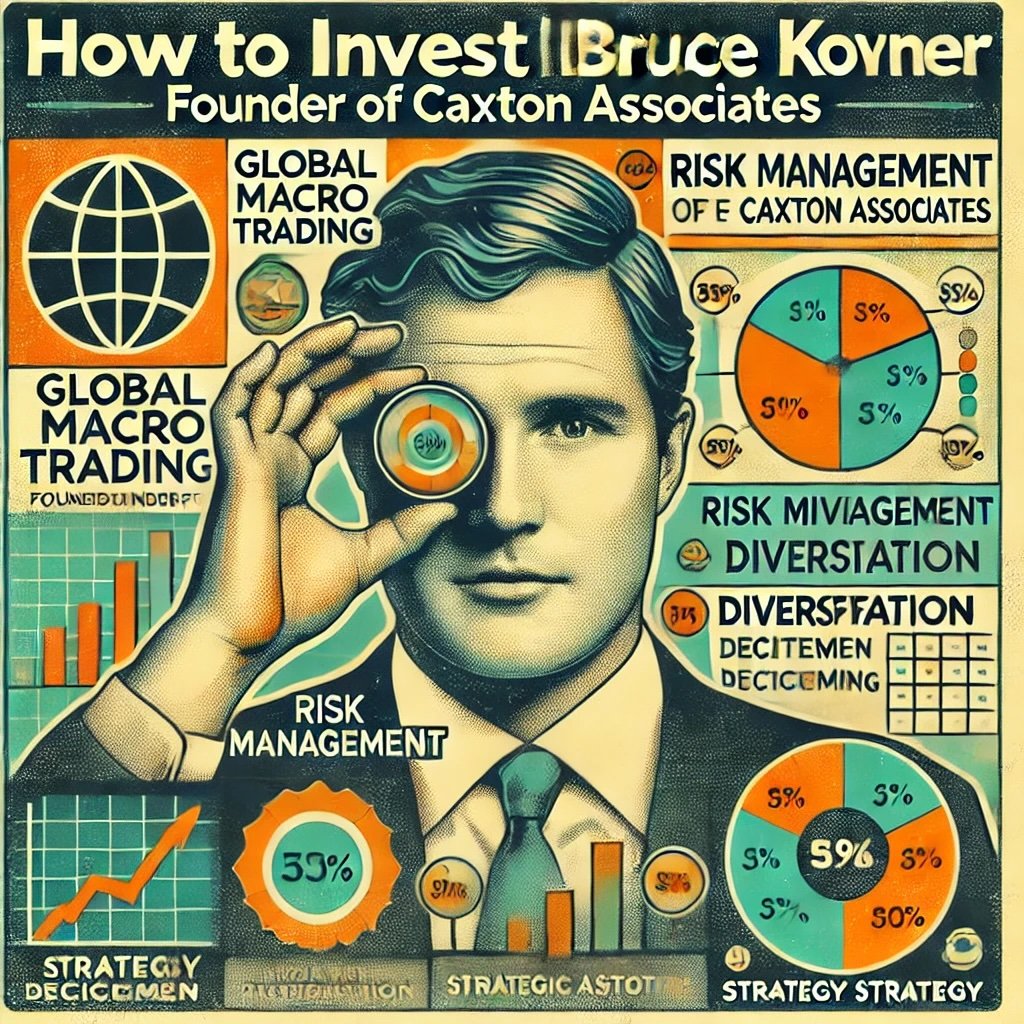
Understanding Forex Trading and Its Significance in Global Finance
Forex trading, or foreign exchange trading, involves buying and selling currencies on the global market with the aim of making profits from fluctuations in exchange rates. As the largest and most liquid financial market in the world, the forex market facilitates international trade and investment, playing a crucial role in global finance. Its significance lies in its ability to provide liquidity, enabling seamless currency conversions for businesses and investors worldwide.
We’ll cover Bruce Kovner’s trading philosophy and strategies. By understanding his approach to global macro trading, investors can gain valuable insights into creating and implementing their own effective trading systems. From risk management to psychological discipline, we’ll cover the multifaceted aspects that make Bruce Kovner a legendary figure in the trading world.
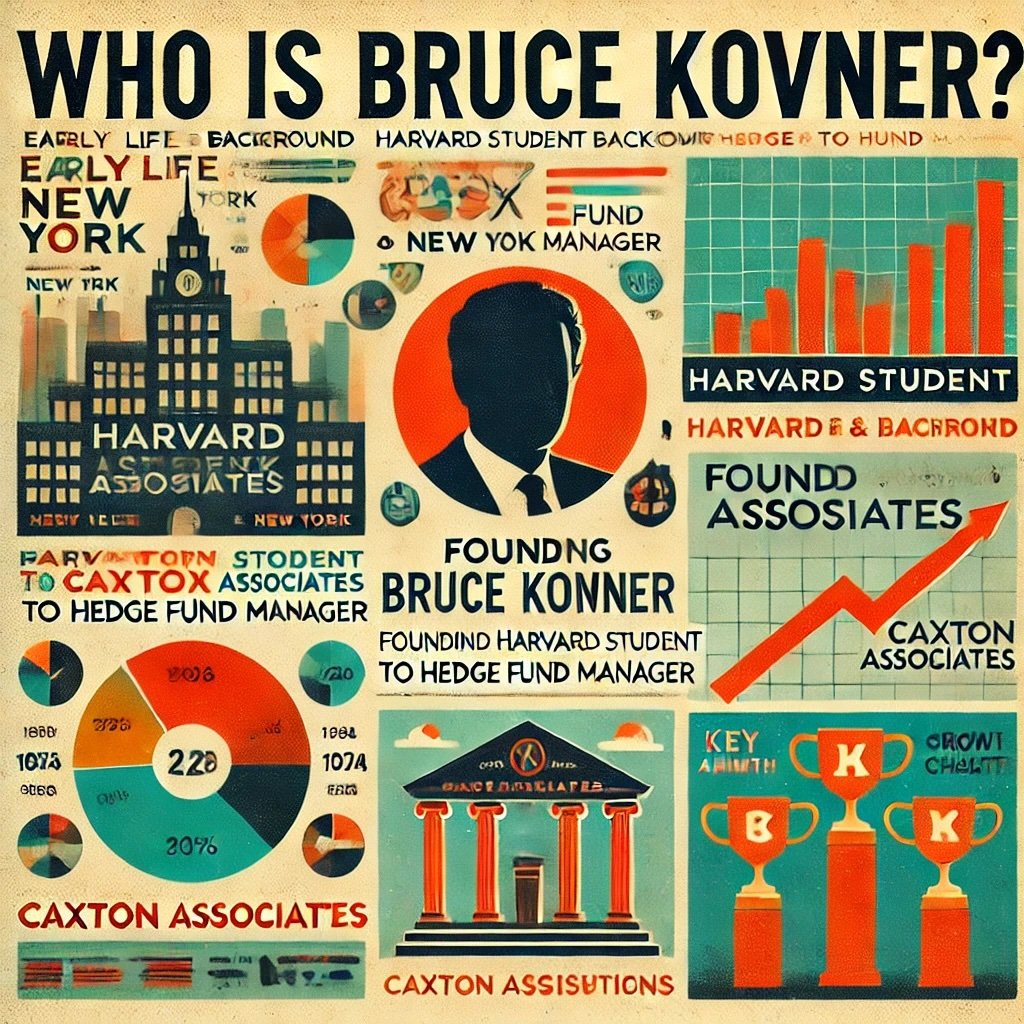
Who is Bruce Kovner?
Early Life and Background
Bruce Kovner was born in Brooklyn, New York, in 1949. His early years were marked by academic excellence and a keen interest in the financial markets. Kovner pursued his undergraduate studies at Harvard University, where he earned a degree in art history. However, his passion for finance and trading soon took center stage, setting him on a path that would lead to monumental success in the hedge fund industry.
Journey from Harvard Student to Legendary Hedge Fund Manager
After graduating from Harvard, Kovner ventured into the world of finance, starting his career as a trader at American Stock Exchange (AMEX). His innate ability to analyze market trends and make strategic trades quickly distinguished him from his peers. Kovner’s relentless pursuit of knowledge and his ability to adapt to changing market conditions were instrumental in his rise within the trading ranks.
In 1983, Kovner founded Caxton Associates, a hedge fund that would go on to become one of the most successful and influential in the industry. Under his leadership, Caxton Associates achieved remarkable performance, consistently delivering impressive returns for its investors. Kovner’s strategic foresight and disciplined approach to trading earned him the reputation of a trading maestro.
Key Achievements and Contributions
- Founding Caxton Associates: In 1983, Kovner established Caxton Associates, which quickly rose to prominence as a leading hedge fund, renowned for its exceptional performance and innovative trading strategies.
- Consistent Performance: Under Kovner’s leadership, Caxton Associates consistently outperformed the market, delivering substantial returns even during volatile periods.
- Global Macro Pioneer: Kovner is credited with pioneering the global macro trading approach, which involves making investment decisions based on macroeconomic trends across various asset classes and regions.
- Philanthropy and Mentorship: Beyond his trading success, Kovner is known for his philanthropic endeavors and commitment to mentoring the next generation of traders, sharing his insights and experiences to foster growth and excellence in the trading community.
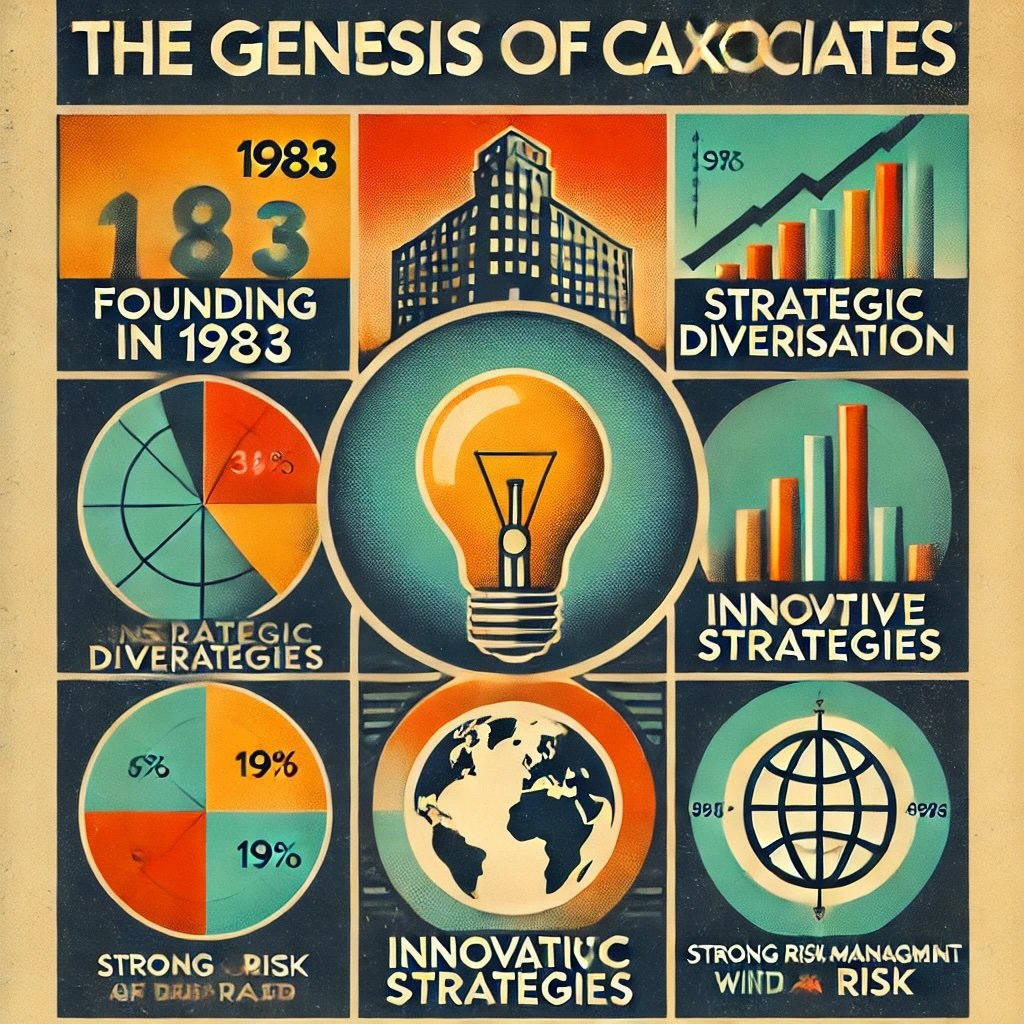
The Genesis of Caxton Associates
Founding of Caxton Associates in 1983
In 1983, Bruce Kovner took a bold step by founding Caxton Associates, a hedge fund that would revolutionize the trading landscape. Caxton Associates was established with a clear vision: to leverage global macroeconomic trends and sophisticated trading strategies to achieve superior returns for its investors. Kovner’s leadership and strategic acumen were instrumental in shaping Caxton’s direction and success.
Caxton’s Rise to Prominence in the Hedge Fund Industry
From its inception, Caxton Associates distinguished itself through its innovative trading approaches and rigorous risk management. The fund’s focus on global macro trading allowed it to capitalize on diverse opportunities across currencies, commodities, equities, and fixed income. This diversified approach not only enhanced returns but also mitigated risks, positioning Caxton as a formidable player in the hedge fund industry.
Key factors contributing to Caxton’s rise include:
- Strategic Diversification: Caxton’s ability to trade across multiple asset classes and regions provided it with a broad spectrum of opportunities, enhancing its adaptability and resilience.
- Innovative Strategies: Kovner’s emphasis on developing and refining sophisticated trading strategies set Caxton apart from its competitors, allowing it to stay ahead of market trends and capitalize on emerging opportunities.
- Strong Risk Management: A core tenet of Caxton’s success was its stringent risk management protocols, ensuring that capital was preserved and losses were minimized even during adverse market conditions.
Key Milestones and Performance Highlights Under Kovner’s Leadership
- Early Success: Within the first few years, Caxton Associates achieved significant returns, attracting substantial investments and establishing itself as a top-performing hedge fund.
- Navigating Market Crises: Caxton demonstrated remarkable resilience during market downturns, consistently delivering positive returns when many other funds faltered. This ability to navigate crises underscored the effectiveness of its global macro approach and risk management strategies.
- Expanding Influence: Over the years, Caxton Associates expanded its influence, attracting a diverse clientele and solidifying its reputation as a premier hedge fund with a global reach.
- Continued Excellence: Under Kovner’s stewardship, Caxton continued to excel, consistently outperforming benchmarks and delivering exceptional returns, cementing its status as a leader in the hedge fund industry.
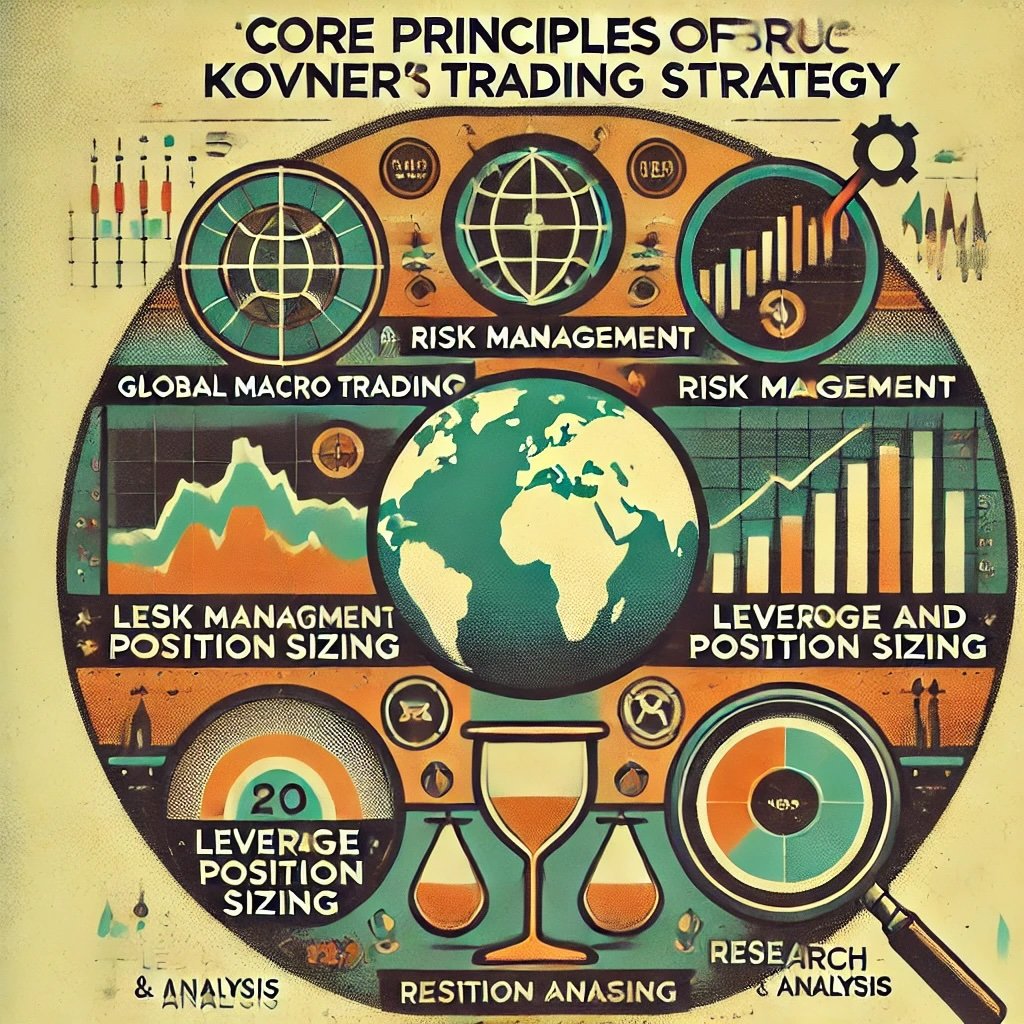
Core Principles of Bruce Kovner’s Trading Strategy
Bruce Kovner’s trading strategy is built upon several core principles that ensure disciplined, strategic, and resilient trading. These principles form the foundation of his success and can serve as a guide for traders aspiring to emulate his approach.
1. Global Macro Trading: Leveraging Macroeconomic Trends
Global macro trading is a strategy that involves making investment decisions based on macroeconomic trends and events. Kovner focuses on analyzing economic indicators, political developments, and global market dynamics to identify trading opportunities across various asset classes.
Key Components of Global Macro Trading:
- Economic Analysis: Assessing macroeconomic indicators such as GDP growth, inflation rates, interest rates, and employment figures to gauge economic health and anticipate market movements.
- Political Analysis: Understanding the impact of political events, policy changes, and geopolitical tensions on financial markets.
- Market Sentiment: Gauging investor sentiment and market psychology to predict trends and reversals.
- Diverse Asset Classes: Trading across multiple asset classes, including currencies, commodities, equities, and fixed income, to capitalize on global trends.
2. Risk Management: Capital Preservation and Disciplined Risk-Taking
Effective risk management is paramount in Kovner’s trading philosophy. He emphasizes the importance of preserving capital and taking calculated risks to ensure long-term profitability.
Core Aspects of Kovner’s Risk Management:
- Position Sizing: Determining the appropriate amount to invest in each trade based on the level of risk. Kovner often allocates a small percentage of the portfolio to any single trade to minimize exposure.
- Stop-Loss Orders: Implementing predefined exit points to limit potential losses on trades. This ensures that losses are contained and do not significantly impact the overall portfolio.
- Diversification: Spreading investments across various asset classes and regions to reduce concentration risk and enhance portfolio resilience.
- Leverage Control: Using leverage judiciously to amplify returns while keeping potential losses in check. Kovner maintains a balanced approach to leverage, ensuring that it does not expose the portfolio to undue risk.
3. Leverage and Position Sizing: Maximizing Returns While Managing Risk
Leverage allows traders to amplify their exposure to the market without committing additional capital. Kovner effectively uses leverage to enhance returns while meticulously managing associated risks.
Strategies for Effective Leverage and Position Sizing:
- Volatility-Based Position Sizing: Adjusting the size of each position based on the volatility of the asset. More volatile assets receive smaller positions to mitigate risk, while less volatile assets can support larger positions.
- Fixed Percentage Allocation: Allocating a fixed percentage of the portfolio to each trade ensures that no single trade can disproportionately impact overall performance.
- Dynamic Positioning: Continuously reassessing and adjusting position sizes based on changing market conditions and portfolio performance.
4. Research and Analysis: Rigorous Evaluation of Trading Opportunities
Thorough research and analysis are integral to Kovner’s trading strategy. He believes that informed decisions stem from a deep understanding of market dynamics and the factors influencing asset prices.
Key Components of Research and Analysis:
- Fundamental Analysis: Evaluating the intrinsic value of assets based on economic indicators, company performance, and industry trends.
- Technical Analysis: Studying price charts, patterns, and technical indicators to identify trends and predict future price movements.
- Quantitative Analysis: Utilizing statistical and mathematical models to assess market conditions and optimize trading strategies.
- Sentiment Analysis: Gauging market sentiment through news analysis, social media monitoring, and investor behavior studies to anticipate market trends.
Integration of Core Principles
Kovner’s trading strategy seamlessly integrates these core principles, creating a robust and adaptable trading framework capable of navigating various market environments. By combining global macro insights with stringent risk management, effective leverage usage, and rigorous research, Kovner ensures that his trading approach remains disciplined and resilient, consistently delivering superior returns.

Famous Trades and Market Calls
Bruce Kovner’s illustrious career is marked by several notable trades and market calls that highlight the effectiveness of his global macro trading strategies. These trades not only demonstrate his ability to capitalize on market opportunities but also provide valuable lessons for traders seeking to emulate his success.
1. The 1987 Black Monday Trade
One of Kovner’s most celebrated trades occurred during the 1987 stock market crash, famously known as Black Monday. On October 19, 1987, global stock markets plummeted, with the Dow Jones Industrial Average (DJIA) falling by 22.6% in a single day.
Strategy Behind the Trade:
- Anticipating the Downturn: Kovner’s global macro analysis indicated underlying vulnerabilities in the market, prompting him to take a bearish stance.
- Currency Hedge: He shifted significant portions of his portfolio into safe-haven currencies like the Japanese Yen (JPY) and Swiss Franc (CHF), anticipating a flight to safety as investors sought refuge from the crashing markets.
- Short Positions: Kovner took short positions in equities, capitalizing on the rapid decline in stock prices.
Outcome and Impact:
As the markets crashed, Kovner’s bearish positions yielded substantial profits, demonstrating the effectiveness of his risk management and ability to anticipate market movements. This trade underscored the importance of diversification and the strategic use of safe-haven assets during periods of extreme market volatility.
2. The 1997 Asian Financial Crisis
During the Asian Financial Crisis of 1997, several Asian economies faced severe currency devaluations, leading to widespread financial instability. Kovner adeptly navigated this crisis, leveraging his global macro strategies to capitalize on the ensuing market movements.
Strategy During the Crisis:
- Currency Bets: Kovner placed substantial bets against the Thai Baht (THB) and other affected Asian currencies, anticipating further devaluations.
- Asset Diversification: He diversified his investments across various asset classes, including commodities and global equities, to mitigate risk and capitalize on emerging opportunities.
- Hedging Techniques: Kovner employed hedging strategies to protect his portfolio from adverse movements, ensuring capital preservation while positioning for gains.
Outcome and Lessons:
Kovner’s strategic positioning during the Asian Financial Crisis resulted in significant profits, highlighting the importance of understanding regional economic dynamics and the ability to adapt trading strategies in response to unfolding events. This trade reinforced the value of rigorous research and the ability to identify and act on macroeconomic trends.
3. The 2008 Global Financial Crisis
The 2008 Global Financial Crisis was a tumultuous period that tested the resilience of even the most seasoned traders. Kovner’s disciplined approach and robust risk management allowed him to not only protect his capital but also seize profitable opportunities amidst the chaos.
Strategy During the Crisis:
- Safe-Haven Assets: Kovner increased his holdings in safe-haven currencies and assets, such as gold and U.S. Treasuries, anticipating a flight to safety as global confidence waned.
- Short Positions: He took short positions in distressed financial institutions and overvalued asset classes, profiting from the sharp declines in their valuations.
- Global Diversification: Kovner maintained a globally diversified portfolio, reducing exposure to any single market and enhancing overall portfolio resilience.
Outcome and Lessons:
Kovner’s strategic moves during the 2008 crisis not only safeguarded his portfolio but also generated impressive returns. This period highlighted the critical importance of capital preservation, aggressive risk management, and the ability to identify and exploit distressed market conditions. Kovner’s success during the crisis serves as a testament to the efficacy of his global macro trading principles.
Key Takeaways from Kovner’s Famous Trades
- Anticipate Market Movements: Kovner’s ability to foresee market downturns and act proactively underscores the importance of predictive analysis in trading.
- Diversification and Hedging: Spreading investments across various asset classes and employing hedging techniques are essential for mitigating risk and enhancing portfolio resilience.
- Capital Preservation: Prioritizing capital preservation, especially during volatile periods, ensures long-term trading success and sustainability.
- Adaptability: The ability to adapt trading strategies in response to evolving market conditions is crucial for capitalizing on emerging opportunities and minimizing losses.
Relevance of Kovner’s Trades Today
The principles demonstrated in Kovner’s notable trades remain highly relevant in today’s financial markets. With the continuous evolution of global economies and the emergence of new asset classes, the need for a disciplined, diversified, and adaptable trading approach is more critical than ever. Kovner’s strategies offer timeless lessons on leveraging macroeconomic trends, managing risk, and maintaining emotional discipline, providing a robust blueprint for traders aiming for sustained success.
Risk Management Techniques
Bruce Kovner’s Approach to Managing Risk in Global Macro Trading
Risk management is the cornerstone of Bruce Kovner’s trading philosophy. His meticulous approach ensures that his capital is protected and potential losses are minimized, allowing for sustained trading success even in volatile global markets. Kovner understands that preserving capital is essential for capitalizing on future opportunities, and his strategies reflect this fundamental principle.
1. Position Sizing: Allocating the Right Amount
Position sizing is a critical component of Kovner’s risk management strategy. Determining the appropriate amount to invest in each trade based on the level of risk ensures that no single trade can significantly impact the overall portfolio.
Key Strategies for Position Sizing:
- Fixed Percentage Allocation: Kovner often allocates a fixed percentage of the portfolio to each trade, typically between 1-5%. This approach ensures that losses on any single trade do not exceed a manageable portion of the portfolio.
- Volatility-Based Sizing: Adjusting position sizes based on the volatility of the asset being traded. More volatile assets receive smaller positions to mitigate risk, while less volatile assets can support larger positions.
- Dynamic Positioning: Continuously reassessing and adjusting position sizes based on changing market conditions and portfolio performance, maintaining a balanced risk exposure.
2. Stop-Loss Orders: Limiting Potential Losses
Stop-loss orders are predefined exit points set to limit potential losses on trades. Kovner employs stop-loss orders as a fundamental component of his risk management strategy, ensuring that losses are contained and do not spiral out of control.
Implementing Stop-Loss Orders:
- Technical Levels: Placing stop-loss orders at key technical levels, such as support or resistance points, ensures that they are not triggered by minor market fluctuations. This strategic placement minimizes the likelihood of premature exits.
- Dynamic Stop-Loss: Adjusting stop-loss levels based on market conditions and the evolving trend allows for flexibility while maintaining protection. Trailing stops are used to lock in profits as the trade moves in a favorable direction.
- Automated Execution: Utilizing algorithms to automatically execute stop-loss orders when predefined conditions are met ensures timely and emotion-free exits, maintaining discipline and consistency.
3. Diversification: Spreading Risk Across Markets
Diversification is a vital risk management technique that involves spreading investments across various asset classes, regions, and sectors to reduce exposure to any single source of risk. Kovner’s global macro approach naturally incorporates diversification, enhancing portfolio resilience.
Diversification Strategies:
- Asset Class Diversification: Investing in a mix of currencies, commodities, equities, and fixed income to balance risk and return. This broad exposure allows Kovner to capitalize on diverse market opportunities while mitigating sector-specific risks.
- Geographical Diversification: Allocating investments across different regions and economies reduces the impact of localized economic downturns or political instability, ensuring that the portfolio remains robust against regional shocks.
- Sector Diversification: Spreading investments across various sectors helps avoid concentration risk and capitalizes on opportunities in different industries, enhancing overall portfolio performance.
4. Leverage Control: Maximizing Returns While Managing Risk
While leverage can amplify returns, it also increases the potential for significant losses. Kovner employs leverage judiciously, ensuring that it enhances returns without exposing the portfolio to undue risk.
Strategies for Effective Leverage Control:
- Conservative Leverage Levels: Using leverage levels that align with his risk tolerance and trading strategy, avoiding excessive exposure that could jeopardize capital.
- Monitoring Leverage: Continuously monitoring leveraged positions to ensure they remain within acceptable risk parameters, adjusting leverage as needed based on market conditions.
- Risk-Adjusted Returns: Evaluating the potential returns against the associated risks to determine appropriate leverage levels for each trade, aiming for a balanced risk-reward ratio.
5. Hedging Techniques: Protecting Against Adverse Movements
Hedging involves taking positions in related assets to offset potential losses in the primary investment. Kovner employs hedging strategies to protect his portfolio from adverse market movements, ensuring capital preservation during volatile periods.
Hedging Strategies:
- Currency Hedging: Using currency derivatives or forward contracts to hedge against unfavorable currency movements, protecting international investments from exchange rate volatility.
- Commodity Hedging: Investing in commodity futures or options to hedge against price fluctuations in commodity markets, balancing exposure across different asset classes.
- Equity Hedging: Utilizing options or short positions in equities to hedge against potential declines in stock markets, maintaining portfolio balance.
Balancing Risk and Reward: Ensuring Sustainable Profitability
Balancing risk and reward is essential for optimizing portfolio performance. Kovner’s approach ensures that each trade offers a favorable risk-reward ratio, enhancing the potential for sustained profitability.
Strategies for Balancing Risk and Reward:
- Risk-Reward Ratio: Targeting trades where the potential reward significantly outweighs the risk, such as aiming for a 2:1 or 3:1 ratio. This ensures that profitable trades can offset losses from less successful ones.
- Thorough Analysis: Conducting comprehensive research and analysis to assess the viability and potential returns of each investment, ensuring informed and strategic decision-making.
- Continuous Monitoring: Regularly reviewing and adjusting the portfolio to maintain an optimal balance between risk and reward, responding to changing market conditions and evolving trends.
Implementing Kovner’s Risk Management Techniques
To effectively implement Kovner’s risk management techniques, traders should:
- Define Risk Parameters: Clearly outline the maximum acceptable loss per trade and overall portfolio risk, ensuring alignment with personal risk tolerance and trading objectives.
- Utilize Technology: Leverage trading platforms and software to automate risk management measures, ensuring consistent application and reducing the potential for human error.
- Regularly Review Strategies: Continuously assess and refine risk management strategies to adapt to evolving market dynamics, incorporating new insights and data to enhance effectiveness.
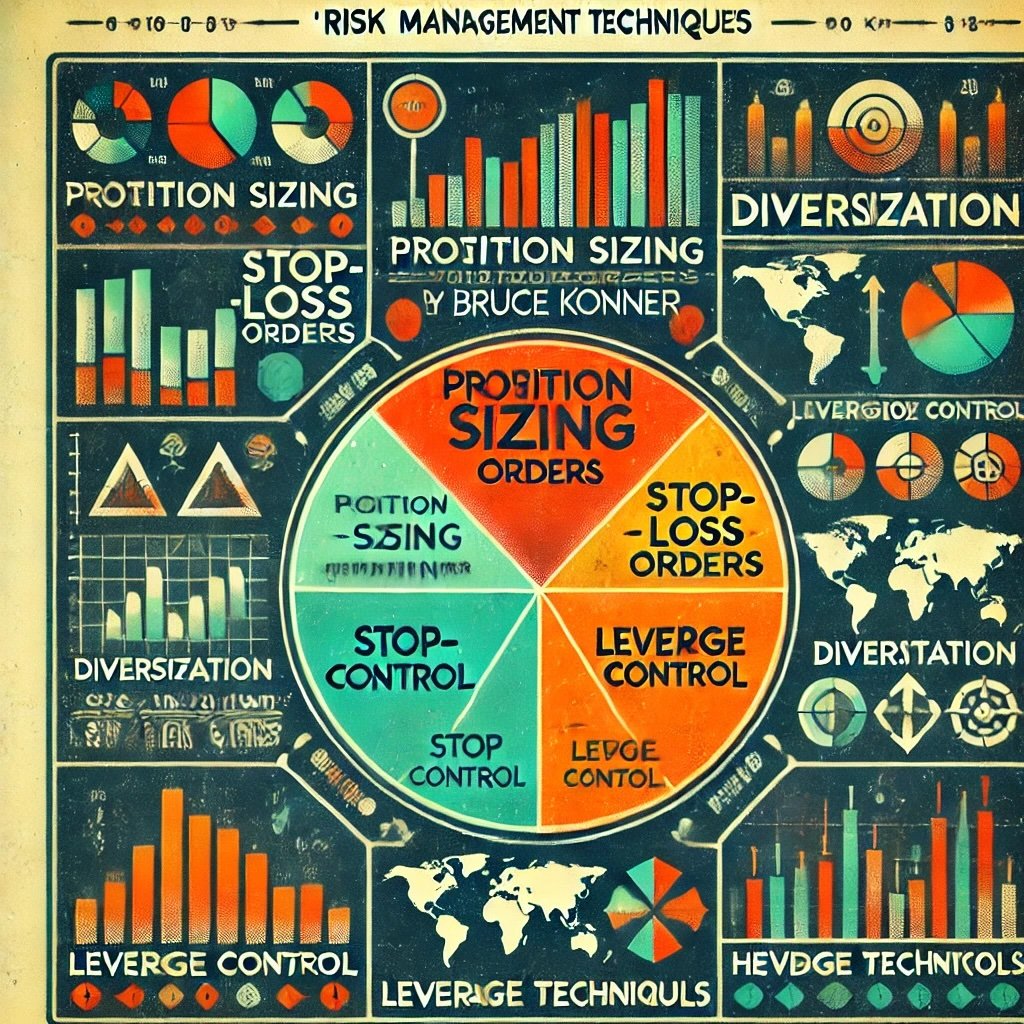
The Role of Psychology in Trading
Bruce Kovner’s Views on the Psychological Challenges of Trading
Bruce Kovner acknowledges that psychology plays a pivotal role in trading, even within the framework of systematic strategies. While technical analysis and risk management are critical, the trader’s mindset and emotional control significantly influence trading performance and decision-making. Kovner emphasizes the importance of maintaining emotional discipline to execute strategies effectively and consistently.
Techniques for Maintaining Discipline and Emotional Control
Maintaining discipline and emotional control is essential for traders to execute strategies effectively and avoid impulsive decisions that can lead to significant losses. Kovner employs several techniques to cultivate these traits:
1. Developing Emotional Resilience
Emotional resilience enables traders to handle the inevitable ups and downs of the market without succumbing to stress or making rash decisions.
- Mindfulness and Meditation: Engaging in mindfulness practices helps in maintaining focus, reducing stress, and enhancing emotional balance during trading sessions.
- Physical Fitness: Regular exercise contributes to overall mental well-being, enhancing cognitive function and emotional resilience.
- Continuous Learning: Staying informed and educated builds confidence and reduces anxiety, empowering traders to make informed decisions without fear.
2. Adhering to a Strict Trading Plan
Discipline is the backbone of successful trading. Kovner emphasizes the importance of sticking to a predefined trading plan to avoid impulsive decisions driven by emotions.
- Predefined Rules: Clearly outlining entry and exit criteria based on technical analysis ensures objective decision-making.
- Routine and Structure: Establishing a consistent trading routine reinforces disciplined behavior and minimizes emotional interference.
- Automated Trading Systems: Utilizing automated systems to execute trades based on predefined rules reduces the potential for emotional interference, ensuring consistency.
Impact of Psychology on Trading Performance and System Adherence
Psychological factors significantly influence trading performance and the ability to adhere to systematic strategies:
- Emotional Control: The ability to manage emotions like fear and greed ensures that trading decisions remain objective and consistent.
- Confidence: Building confidence through successful trades and thorough understanding of trading systems enhances performance.
- Stress Management: Effective stress management techniques prevent emotional burnout and maintain mental clarity during volatile market conditions.
Kovner’s Psychological Strategies
Kovner employs several psychological strategies to maintain discipline and emotional resilience:
- Journaling: Keeping a trading journal to document trades, emotions, and reflections helps identify patterns and areas for improvement.
- Setting Realistic Goals: Establishing achievable trading goals maintains motivation and avoids undue pressure.
- Developing a Support System: Engaging with fellow traders, mentors, or support groups to share experiences and gain insights fosters a sense of community and accountability.
Importance of Mental Resilience in Executing Trades Effectively
Mental resilience enables traders to:
- Handle Losses: Accept and learn from losses without becoming discouraged or deviating from the trading system.
- Stay Focused: Maintain focus on long-term goals and strategies, even during periods of market turbulence.
- Adapt to Change: Remain adaptable and open to refining strategies based on new information and evolving market conditions.
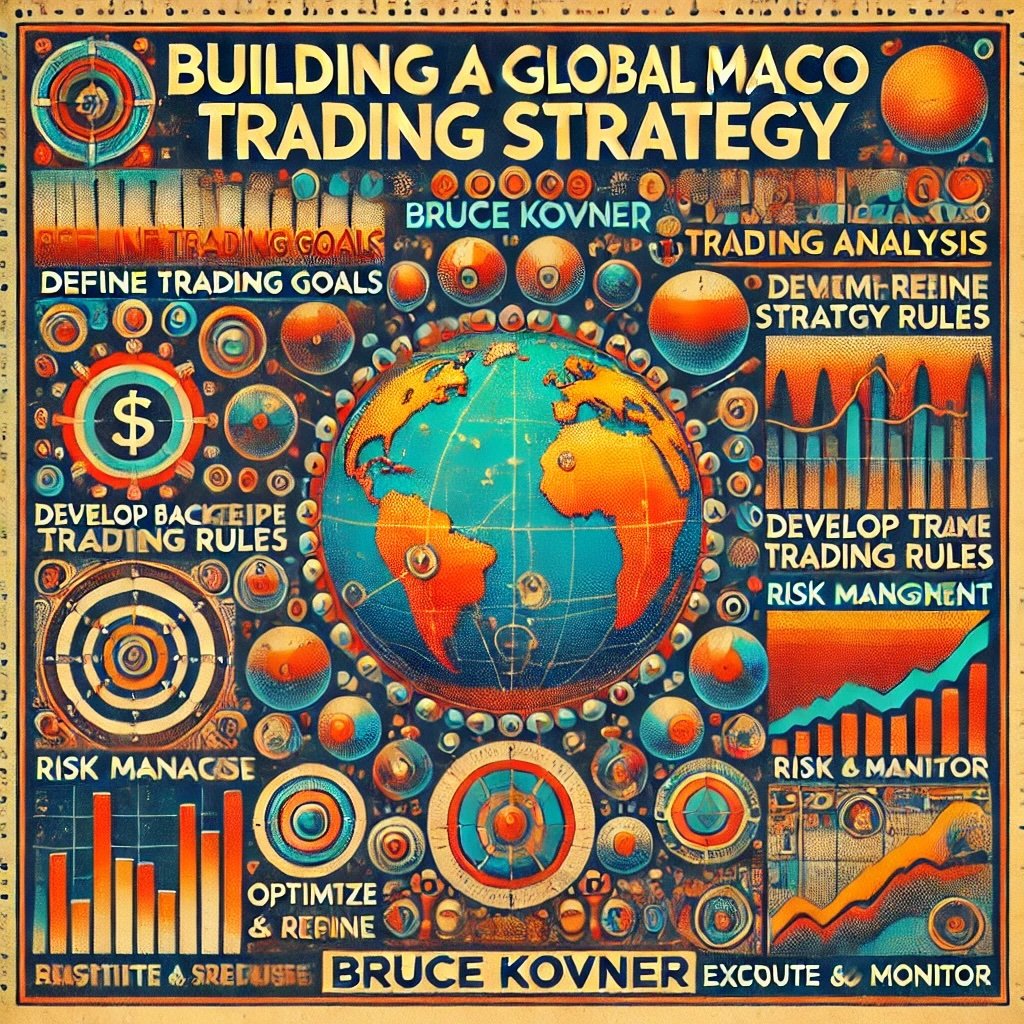
Building a Global Macro Trading Strategy
Step-by-Step Guide to Developing a Global Macro Trading Strategy Inspired by Kovner
Creating a robust global macro trading strategy requires a structured and disciplined approach. Here’s a step-by-step guide inspired by Bruce Kovner’s methodologies:
1. Define Your Trading Goals
- Identify Objectives: Determine what you aim to achieve with your trading strategy, whether it’s capital growth, income generation, or risk mitigation.
- Set Time Horizons: Establish short-term and long-term goals to guide your trading activities, ensuring alignment with your overall financial objectives.
2. Conduct Comprehensive Market Analysis
- Data Collection: Gather historical price data, economic indicators, and other relevant information from reliable sources.
- Trend Identification: Use statistical tools and technical analysis to identify trends and patterns in the data, focusing on sustained movements that can be capitalized upon.
3. Develop Trading Rules and Algorithms
- Rule Creation: Define specific criteria for entering and exiting trades based on your analysis. This includes identifying key technical indicators and signals that indicate potential trading opportunities.
- Algorithm Development: Translate your trading rules into algorithms that can execute trades automatically. This ensures consistency and removes emotional bias from the trading process.
4. Backtest Your Strategy
- Historical Testing: Apply your trading strategy to historical data to evaluate its performance. This helps in assessing the viability and profitability of the strategy before deploying it in live markets.
- Performance Metrics: Analyze key metrics such as profitability, drawdowns, win-loss ratios, and risk-adjusted returns to gauge the effectiveness of your strategy.
5. Optimize and Refine Your Strategy
- Parameter Tuning: Adjust the parameters of your trading rules and algorithms to enhance performance. This may involve tweaking indicator settings or adjusting risk management protocols.
- Validation: Test the optimized strategy on out-of-sample data to ensure its robustness and adaptability to different market conditions.
6. Implement Risk Management Techniques
- Position Sizing: Determine the appropriate size for each trade based on your risk tolerance and the volatility of the currency pair being traded.
- Stop-Loss Orders: Set predefined exit points to limit potential losses, ensuring that no single trade can significantly impact your overall portfolio.
- Diversification: Spread investments across various markets and asset classes to mitigate risk and enhance portfolio resilience.
7. Execute and Monitor Your Strategy
- Automated Execution: Utilize trading platforms that support automated trading to implement your strategy efficiently and consistently.
- Continuous Monitoring: Regularly review the performance of your trading system, tracking key metrics and making adjustments as necessary to maintain optimal performance.
Identifying and Analyzing Potential Trades
- Technical Signals: Use chart patterns and technical indicators to identify potential entry and exit points, ensuring that trades are based on objective criteria.
- Volume Analysis: Assess trading volumes to confirm the strength of trends and validate potential trading signals.
- Economic News: Monitor economic news and data releases that can impact currency prices, adjusting your strategy to account for significant market-moving events.
Tips for Refining and Adapting the Strategy Over Time
- Regular Reviews: Periodically assess your trading strategy’s performance and make necessary adjustments to improve efficiency and profitability.
- Adapt to Market Changes: Be willing to modify your strategy in response to evolving market conditions and new information, ensuring that it remains effective in different environments.
- Continuous Learning: Stay informed about new trading techniques, technologies, and market trends to enhance your strategy and maintain a competitive edge.
- Seek Feedback: Engage with other traders or mentors to gain valuable feedback and incorporate diverse perspectives into your trading strategies.
Sample Global Macro Trading Strategy Inspired by Kovner
Here’s an example of a simple global macro trading strategy inspired by Bruce Kovner:
Strategy Overview
- Markets: Currencies (EUR/USD, USD/JPY, GBP/USD), Commodities (Gold, Oil), Equities (S&P 500, Nikkei 225), Fixed Income (US Treasuries)
- Time Frame: Daily charts for macro trends, 4-hour charts for trade execution
- Indicators: Moving Average Convergence Divergence (MACD), Relative Strength Index (RSI), Bollinger Bands, Economic Indicators (GDP, Inflation Rates)
Entry Rules:
- Long Position: Enter a long position when:
- MACD line crosses above the signal line
- RSI is above 50
- Price is above the 50-day moving average
- Short Position: Enter a short position when:
- MACD line crosses below the signal line
- RSI is below 50
- Price is below the 50-day moving average
Exit Rules:
- Long Position Exit: Exit when:
- MACD line crosses below the signal line
- RSI drops below 50
- Price falls below the 50-day moving average
- Short Position Exit: Exit when:
- MACD line crosses above the signal line
- RSI rises above 50
- Price rises above the 50-day moving average
Risk Management:
- Position Sizing: Allocate 2% of the portfolio to each trade based on risk tolerance and market volatility.
- Stop-Loss Orders: Set a stop-loss at 1% below the entry price for long positions and 1% above for short positions.
- Take-Profit Targets: Set a take-profit target at 2% above the entry price for long positions and 2% below for short positions.

Implementation Steps:
- Define Trading Rules: Clearly outline the conditions for entering and exiting trades based on MACD, RSI, and moving averages.
- Develop Algorithm: Program the rules into a trading platform that supports automated trading, ensuring consistent and objective execution.
- Backtest: Apply the strategy to historical data across multiple asset classes to evaluate its performance, focusing on key metrics like profitability and drawdowns.
- Optimize: Adjust indicator settings or risk parameters to enhance profitability and reduce drawdowns, ensuring the strategy remains robust.
- Forward Test: Implement the strategy in a simulated trading environment to observe real-time performance without risking capital.
- Execute: Deploy the strategy in a live trading account with proper risk management measures in place, adhering strictly to the predefined rules.
- Monitor and Refine: Continuously track the strategy’s performance, making adjustments as necessary to maintain optimal performance and adapt to changing market conditions.
![]()
Challenges of Global Macro Trading
Potential Pitfalls and Difficulties in Adopting a Global Macro Trading Approach
While global macro trading offers substantial opportunities, it also presents several challenges that traders must navigate to achieve success. Understanding these pitfalls and implementing strategies to overcome them is crucial for maintaining a profitable trading career.
1. Complexity of Global Markets
Global macro trading involves analyzing a vast array of economic, political, and social factors across multiple regions and asset classes. This complexity can be overwhelming, requiring a deep understanding of various markets and the ability to synthesize diverse information.
- Risk: Misinterpretation of data or overlooking critical factors can lead to erroneous trading decisions and significant losses.
- Solution: Develop a robust research framework that incorporates multiple sources of information, utilize advanced analytical tools, and maintain a diversified portfolio to mitigate the impact of errors in any single area.
2. High Volatility and Rapid Market Changes
Global macro markets are highly volatile, with currency prices and asset values subject to rapid changes influenced by economic reports, geopolitical events, and market sentiment. This volatility can lead to swift and substantial price movements, posing significant risks.
- Risk: Sudden market shifts can trigger stop-loss orders, resulting in unexpected losses and portfolio instability.
- Solution: Implement strict risk management protocols, including dynamic position sizing and the use of trailing stop-loss orders to protect against adverse movements while allowing for potential gains.
3. Information Overload
The sheer volume of information available to global macro traders can be overwhelming. Traders must filter through vast amounts of data to identify relevant information that can inform their trading decisions.
- Risk: Information overload can lead to analysis paralysis, where traders struggle to make timely decisions, or decision fatigue, resulting in poor judgment.
- Solution: Utilize automated trading systems and data analytics tools to process and analyze large datasets efficiently. Focus on key indicators and prioritize information sources that have the most significant impact on market movements.
4. Execution Challenges
Executing trades across multiple asset classes and regions can be logistically complex. Factors such as differing time zones, varying liquidity levels, and diverse trading regulations add layers of complexity to the trading process.
- Risk: Delays in trade execution or errors in order placement can lead to missed opportunities or unintended exposures.
- Solution: Leverage advanced trading platforms that offer automated execution capabilities, ensure robust connectivity and infrastructure, and stay informed about the regulatory environments in different markets.
5. Psychological Strain
Global macro trading demands a high level of discipline and emotional control. The pressure of making significant trading decisions based on complex analyses can lead to stress and emotional strain, impacting decision-making and trading performance.
- Risk: Emotional fatigue can result in impulsive trades, deviations from the trading plan, and increased susceptibility to market noise.
- Solution: Cultivate emotional resilience through mindfulness practices, maintain a structured trading routine, and adhere strictly to a predefined trading plan to minimize the influence of emotions on trading decisions.
How to Overcome Common Challenges in Global Macro Trading
1. Robust Risk Management
Implement comprehensive risk management strategies to protect capital and minimize losses.
- Position Sizing: Allocate a fixed percentage of the portfolio to each trade based on risk tolerance.
- Stop-Loss Orders: Set predefined exit points to limit potential losses.
- Diversification: Spread investments across various markets and asset classes to mitigate risk.
2. Emotional Discipline
Cultivate emotional resilience to maintain focus and discipline during trading.
- Mindfulness Practices: Engage in activities like meditation to enhance emotional control and reduce stress.
- Trading Journal: Keep a record of trades and emotions to identify patterns and areas for improvement.
- Set Realistic Goals: Establish achievable trading goals to maintain motivation and avoid undue pressure.
3. Continuous Learning and Adaptation
Stay informed and adapt trading strategies based on evolving market conditions.
- Stay Updated: Regularly follow financial news, economic indicators, and market analyses.
- Refine Strategies: Continuously evaluate and adjust trading strategies to align with current market dynamics.
- Seek Feedback: Engage with other traders or mentors to gain insights and refine approaches.
4. Utilize Technology and Tools
Leverage advanced trading platforms and analytical tools to enhance trading efficiency.
- Automated Trading Systems: Use algorithms to execute trades based on predefined rules, reducing emotional interference.
- Analytical Software: Utilize tools like TradingView or MetaTrader for technical analysis and strategy development.
- Data Sources: Access reliable data sources like Bloomberg or Quandl to inform trading decisions.
The Importance of Staying Informed and Adaptable in a Constantly Changing Global Environment
In the dynamic world of global macro trading, staying informed and adaptable is essential for maintaining a competitive edge. Traders must continuously monitor market conditions, economic indicators, and geopolitical events that can influence currency prices and asset values. Being adaptable allows traders to modify their strategies in response to new information, ensuring sustained effectiveness and profitability.
Strategies for Staying Informed and Adaptable:
- Subscribe to Financial News: Regularly follow reputable financial news outlets like Bloomberg, Reuters, and The Wall Street Journal for real-time updates and insights.
- Attend Seminars and Webinars: Participate in industry seminars, webinars, and conferences to gain insights from experts and stay abreast of the latest trends.
- Network with Professionals: Engage with other traders, analysts, and financial professionals to exchange ideas and perspectives.
- Regular Strategy Reviews: Periodically assess and refine your trading strategies to ensure they remain aligned with current market conditions and your investment goals.
![]()
How to Start Trading Like Bruce Kovner
Practical Steps for Implementing Kovner’s Strategies in Your Own Trading
Emulating Bruce Kovner’s trading approach requires a blend of strategic planning, disciplined execution, and continuous learning. Here’s a step-by-step guide to help you incorporate Kovner’s methodologies into your own trading practice:
1. Develop a Strong Foundation in Global Macro Trading
Before diving into trading, it’s essential to build a solid understanding of global macro trading principles.
- Educate Yourself: Start by reading books and taking courses on global macro trading. Understanding macroeconomic indicators, geopolitical events, and their impact on various asset classes is crucial.
- Understand Market Dynamics: Gain insights into how different markets—currencies, commodities, equities, and fixed income—interact on a global scale.
2. Create a Comprehensive Trading Plan
A well-structured trading plan serves as your roadmap, guiding your decisions and strategies.
- Define Your Goals: Clearly outline your financial objectives, risk tolerance, and investment horizon.
- Establish Trading Rules: Set specific criteria for entering and exiting trades based on macroeconomic trends and technical indicators.
- Risk Management Protocols: Incorporate strategies for position sizing, stop-loss orders, and diversification to protect your capital.
3. Conduct Rigorous Research and Analysis
Kovner emphasizes the importance of thorough research in identifying profitable trading opportunities.
- Stay Informed: Regularly follow financial news, economic reports, and geopolitical developments that can influence market movements.
- Data-Driven Decisions: Use quantitative analysis and statistical models to assess potential trades, ensuring decisions are based on solid data rather than intuition.
4. Implement Strategic Risk Management
Protecting your capital is paramount in Kovner’s trading philosophy.
- Position Sizing: Allocate an appropriate portion of your portfolio to each trade based on the level of risk and volatility.
- Diversification: Spread your investments across various asset classes and regions to mitigate the impact of adverse movements in any single market.
- Use of Stop-Loss Orders: Set predefined exit points to limit potential losses, ensuring that no single trade can significantly impact your overall portfolio.
5. Leverage Technology and Trading Platforms
Utilizing advanced tools can enhance your trading efficiency and accuracy.
- Trading Software: Invest in reliable trading platforms that offer robust analytical tools, real-time data, and automation capabilities.
- Algorithmic Trading: Consider developing or using existing algorithms to execute trades based on predefined criteria, reducing emotional interference.
6. Practice Patience and Discipline
Maintaining emotional control and sticking to your trading plan are essential for long-term success.
- Avoid Overtrading: Focus on high-conviction trades that align with your strategic analysis rather than chasing every market movement.
- Stay Disciplined: Adhere strictly to your trading rules and risk management protocols, even during periods of market volatility.
7. Continuously Monitor and Refine Your Strategy
The financial markets are dynamic, and your trading strategy should evolve accordingly.
- Performance Tracking: Regularly review your trading performance using key metrics such as return on investment (ROI), drawdowns, and risk-adjusted returns.
- Strategy Optimization: Adjust your trading rules and risk management techniques based on performance data and changing market conditions.
- Stay Adaptable: Be willing to pivot your strategies in response to new information or shifts in global economic trends.
Resources for Learning More About Global Macro Trading Techniques
To deepen your understanding of global macro trading and refine your strategies, consider the following resources:
Books
- Global Macro Trading: Profiting in a New World Economy by Greg Gliner
- Currency Trading for Dummies by Brian Dolan and Kathleen Brooks
- Trading in the Zone by Mark Douglas
- The Alchemy of Finance by George Soros
Online Courses
- Coursera’s Financial Markets by Yale University: Offers comprehensive insights into financial markets and trading strategies.
- edX’s Introduction to Global Financial Markets: Provides foundational knowledge of global financial systems and instruments.
- Udemy’s Global Macro Trading Strategies: Focuses on developing and implementing macro trading strategies.
Websites and Journals
- Investopedia: Features a wealth of articles and tutorials on global macro trading and related financial concepts.
- TradingView: Offers advanced charting tools and a community of traders sharing insights and strategies.
- The Journal of Portfolio Management: Provides in-depth research and analysis on portfolio management and trading strategies.
Tools and Platforms to Support Global Macro Trading Activities
Leveraging the right tools and platforms is essential for developing, testing, and executing global macro trading strategies. Here are some recommended options:
Trading Platforms
- MetaTrader 5: Known for its advanced charting capabilities, automated trading features, and user-friendly interface.
- Thinkorswim by TD Ameritrade: Offers comprehensive trading tools, real-time data, and support for automated trading strategies.
- Interactive Brokers’ Trader Workstation (TWS): Renowned for its extensive range of tradable assets, low commission rates, and robust trading tools.
Analytical Tools
- Bloomberg Terminal: Delivers in-depth financial data, analytics, and trading tools for professional traders.
- TradingView: Provides powerful charting tools, a vibrant community of traders, and the ability to backtest trading strategies.
- NinjaTrader: Offers advanced charting, market analytics, and automated trading capabilities.
Data Sources
- Quandl: Provides access to a vast array of financial, economic, and alternative datasets for quantitative analysis.
- Federal Reserve Economic Data (FRED): A comprehensive database of economic data and indicators essential for macro analysis.
- World Bank Data: Offers global economic data and development indicators useful for understanding macroeconomic trends.
Algorithmic Trading Platforms
- QuantConnect: A cloud-based platform that supports algorithmic trading and provides access to historical market data.
- Quantopian (now part of Robinhood): Offers tools and resources for developing and testing trading algorithms.
- AlgoTrader: An institutional-grade algorithmic trading software for developing, automating, and executing quantitative trading strategies.
Building Analytical Skills for Global Macro Trading
Developing strong analytical skills is crucial for designing and implementing effective global macro trading strategies. Focus on the following areas:
1. Economic Analysis
- Understanding Indicators: Learn how to interpret macroeconomic indicators like GDP, inflation, interest rates, and unemployment rates and their impact on financial markets.
- Market Cycles: Study the different phases of market cycles to anticipate shifts in trends and adjust trading strategies accordingly.
2. Technical Analysis
- Chart Patterns: Master the identification of chart patterns such as head and shoulders, double tops/bottoms, and triangles.
- Technical Indicators: Gain proficiency in using technical indicators like Moving Averages, MACD, RSI, and Bollinger Bands to inform trading decisions.
3. Quantitative Analysis
- Statistical Methods: Develop a strong grasp of statistical concepts such as regression analysis, hypothesis testing, and probability distributions.
- Programming Skills: Learn programming languages like Python or R to develop and implement trading algorithms, enhancing your ability to analyze data and automate trading strategies.
4. Geopolitical Analysis
- Political Events: Assess the impact of political events, policy changes, and international relations on financial markets.
- Global Trends: Understand global economic and geopolitical trends to identify opportunities and risks in various markets.
5. Risk Assessment
- Volatility Analysis: Utilize tools like the Average True Range (ATR) to measure market volatility and inform risk management decisions.
- Correlation Analysis: Understand the relationships between different asset classes and currencies to optimize portfolio diversification and minimize risk.
Bruce Kovner (Founder of Caxton Associates): 12-Question FAQ
Who is Bruce Kovner and why is he influential?
A legendary global-macro trader and the founder of Caxton Associates, Kovner is known for disciplined risk control, cross-asset positioning, and an ability to marry macro fundamentals with tactical technicals.
What is “global macro” in Kovner’s style?
A cross-asset approach that expresses views on growth, inflation, policy, and capital flows via FX, rates, equities, and commodities—often hedged and diversified across regions and time horizons.
What are his core principles?
Preserve capital first, size positions prudently, diversify across themes/markets, demand clear catalysts, and be willing to change your mind quickly when facts change.
How does he generate trade ideas?
Top-down macro research (growth, inflation, balance-of-payments, policy paths), cross-market confirmation (FX/rates/credit/commodities), sentiment extremes, and price action for timing.
How does Kovner time entries and exits?
Enter on asymmetric setups confirmed by price (breaks, retests, divergences); exit on thesis invalidation, adverse policy/flow shifts, or trailing-stop breaches—always before losses compound.
What does risk management look like?
Tight per-trade risk (often ≤1–2% of equity), portfolio “heat” limits, correlation controls, hard stops, and rules that cut losers fast while letting high-conviction winners compound.
How does he use leverage?
Selectively and conservatively—sized to volatility, liquidity, and confidence. Leverage is a tool for efficiency, not a substitute for edge.
How important is diversification?
Central. Themes are expressed across FX, rates, equities, and commodities with offsets/hedges so that no single shock (policy surprise, geopolitics, liquidity air-pocket) sinks the book.
What role do fundamentals vs. technicals play?
Fundamentals shape the core thesis (macro regime, policy path, valuation); technicals refine timing, risk placement, and position adds/cuts.
How does he handle losing streaks and volatility?
Reduce risk, tighten exposure, refocus on highest-quality setups, and wait for clarity—process over prediction, patience over impulse.
How can a retail investor apply Kovner’s ideas?
Build a macro checklist, diversify exposures (including cash/hedges), cap per-position risk, use stops, and review theses against data/calendar rather than headlines.
Common pitfalls to avoid?
Over-sizing FX or single-theme bets, ignoring correlations and liquidity, moving stops, narrative attachment, and reacting to noise instead of the data/plan.
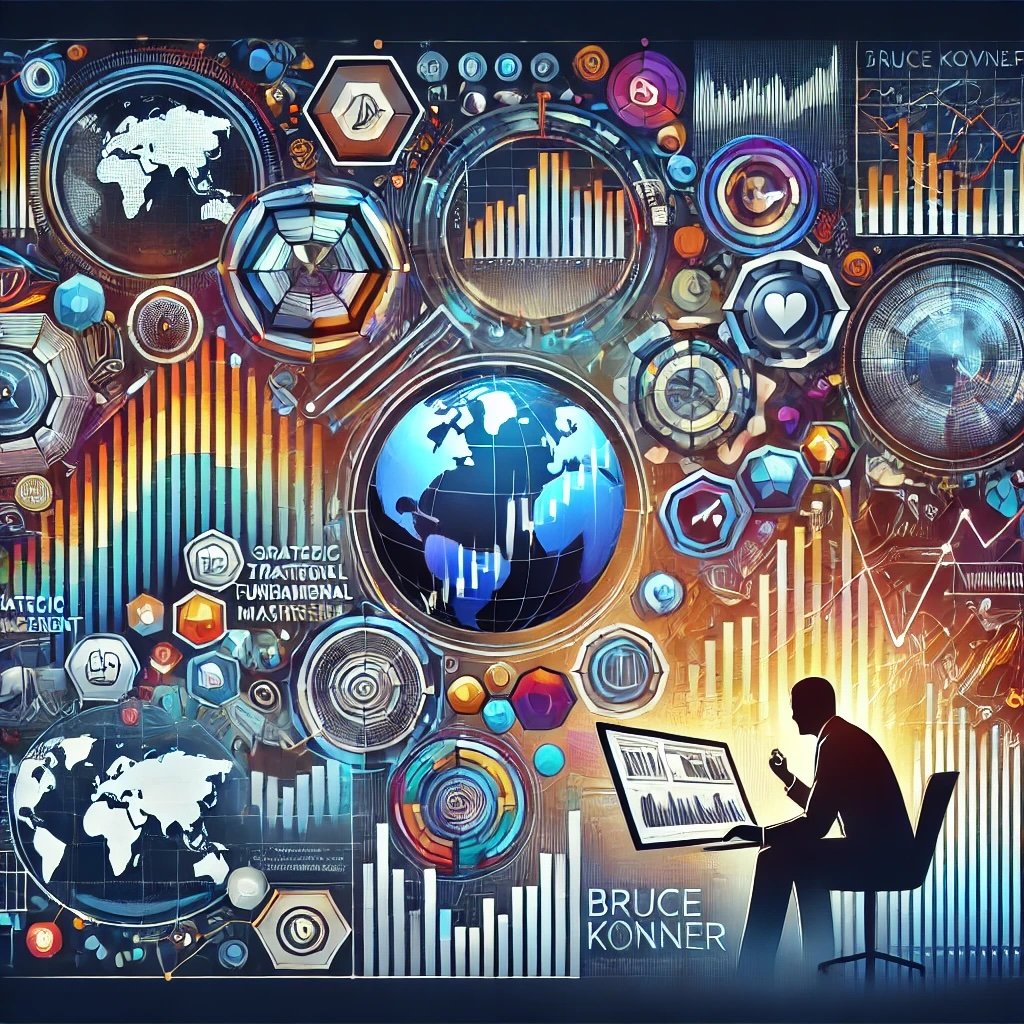
Key Takeaways from Bruce Kovner’s Trading Approach
Bruce Kovner’s trading philosophy and strategies offer a comprehensive framework for achieving success in the highly dynamic and complex world of global macro trading. Here are the key takeaways from his approach:
- Strategic Risk Management: Emphasize controlling risk through position sizing, stop-loss orders, and diversification to protect capital and ensure long-term profitability.
- Market Sentiment Analysis: Leverage market sentiment and technical indicators to inform trading decisions, identifying high-probability trading opportunities.
- Patience and Discipline: Maintain emotional control and adhere strictly to a trading plan, avoiding impulsive decisions driven by emotions or market noise.
- Technical and Fundamental Mastery: Combine technical analysis with fundamental insights to gain a comprehensive understanding of market dynamics and trends.
- Continuous Learning and Adaptation: Commit to ongoing education and strategy refinement to adapt to evolving market conditions, ensuring sustained trading performance.
- Systematic Execution: Implement automated trading systems to execute trades based on predefined rules, ensuring consistency and objectivity in trading decisions.
Relevance of Global Macro Trading in Today’s Markets
Global macro trading remains highly relevant in today’s financial markets, which are characterized by rapid technological advancements, increasing interconnectedness, and constant geopolitical shifts. The principles and strategies championed by Bruce Kovner are particularly pertinent in this environment:
- Technological Integration: The rise of algorithmic trading and artificial intelligence has amplified the importance of systematic, data-driven trading approaches.
- Global Interconnectedness: Economic events in one region can have ripple effects across the globe, making a global macro perspective invaluable for navigating market volatility and identifying opportunities.
- Adaptive Strategies: The ever-evolving nature of global markets necessitates adaptable and flexible trading strategies, ensuring traders can respond effectively to unforeseen changes and emerging trends.
Kovner’s emphasis on comprehensive research, disciplined risk management, and strategic execution provides a timeless blueprint for traders seeking to thrive in the global macro landscape.
Explore and Experiment with These Strategies
Embarking on a global macro trading journey inspired by Bruce Kovner is both challenging and rewarding. It requires a commitment to continuous learning, disciplined execution, and strategic adaptability. However, the potential rewards—consistent profitability, enhanced market insights, and the ability to navigate complex global dynamics—make it a compelling approach for dedicated traders.
As you explore and develop your own trading systems, keep the following in mind:
- Stay Disciplined: Adhere strictly to your trading rules and risk management protocols to maintain consistency and objectivity in your trading decisions.
- Be Patient: Global macro trading often involves waiting for the right market conditions and opportunities. Patience ensures that you enter trades with high conviction.
- Embrace Technology: Leverage advanced trading platforms and analytical tools to enhance your trading capabilities, streamline execution, and facilitate comprehensive market analysis.
- Continuously Refine: Regularly review and optimize your trading systems to ensure they remain effective and aligned with your trading goals. Adaptation is key to maintaining competitiveness in evolving markets.
- Learn from Mistakes: Analyze your trading performance to identify and rectify errors, fostering continuous improvement and strategic growth.
By embracing the principles and strategies of Bruce Kovner, you can navigate the complexities of global financial markets with confidence and strategic insight. Global macro trading offers a pathway to disciplined, consistent, and potentially lucrative trading, embodying the essence of Bruce Kovner’s enduring legacy in the world of finance.
Investing like Bruce Kovner isn’t just about following a set of rules; it’s about cultivating a mindset that prioritizes strategic risk management, comprehensive market analysis, and continuous improvement. By embracing global macro trading principles, you can navigate the financial markets with precision and confidence, unlocking the potential for sustained trading success. Happy trading!
Important Information
Comprehensive Investment Disclaimer:
All content provided on this website (including but not limited to portfolio ideas, fund analyses, investment strategies, commentary on market conditions, and discussions regarding leverage) is strictly for educational, informational, and illustrative purposes only. The information does not constitute financial, investment, tax, accounting, or legal advice. Opinions, strategies, and ideas presented herein represent personal perspectives, are based on independent research and publicly available information, and do not necessarily reflect the views or official positions of any third-party organizations, institutions, or affiliates.
Investing in financial markets inherently carries substantial risks, including but not limited to market volatility, economic uncertainties, geopolitical developments, and liquidity risks. You must be fully aware that there is always the potential for partial or total loss of your principal investment. Additionally, the use of leverage or leveraged financial products significantly increases risk exposure by amplifying both potential gains and potential losses, and thus is not appropriate or advisable for all investors. Using leverage may result in losing more than your initial invested capital, incurring margin calls, experiencing substantial interest costs, or suffering severe financial distress.
Past performance indicators, including historical data, backtesting results, and hypothetical scenarios, should never be viewed as guarantees or reliable predictions of future performance. Any examples provided are purely hypothetical and intended only for illustration purposes. Performance benchmarks, such as market indexes mentioned on this site, are theoretical and are not directly investable. While diligent efforts are made to provide accurate and current information, “Picture Perfect Portfolios” does not warrant, represent, or guarantee the accuracy, completeness, or timeliness of any information provided. Errors, inaccuracies, or outdated information may exist.
Users of this website are strongly encouraged to independently verify all information, conduct comprehensive research and due diligence, and engage with qualified financial, investment, tax, or legal professionals before making any investment or financial decisions. The responsibility for making informed investment decisions rests entirely with the individual. “Picture Perfect Portfolios” explicitly disclaims all liability for any direct, indirect, incidental, special, consequential, or other losses or damages incurred, financial or otherwise, arising out of reliance upon, or use of, any content or information presented on this website.
By accessing, reading, and utilizing the content on this website, you expressly acknowledge, understand, accept, and agree to abide by these terms and conditions. Please consult the full and detailed disclaimer available elsewhere on this website for further clarification and additional important disclosures. Read the complete disclaimer here.



